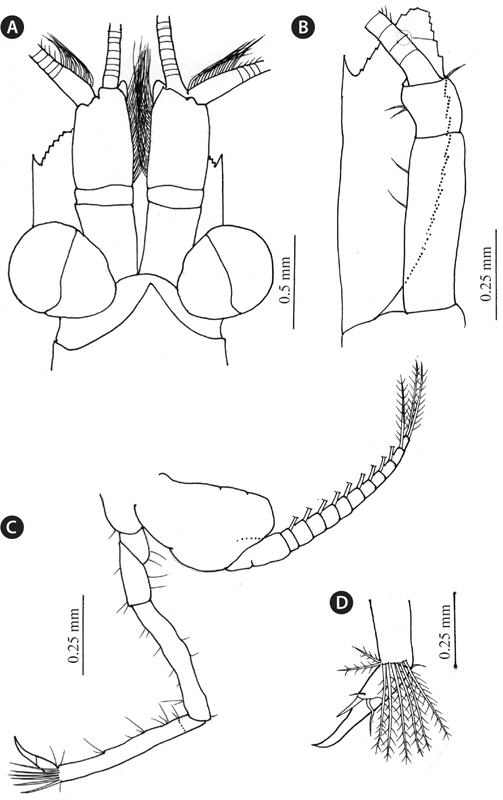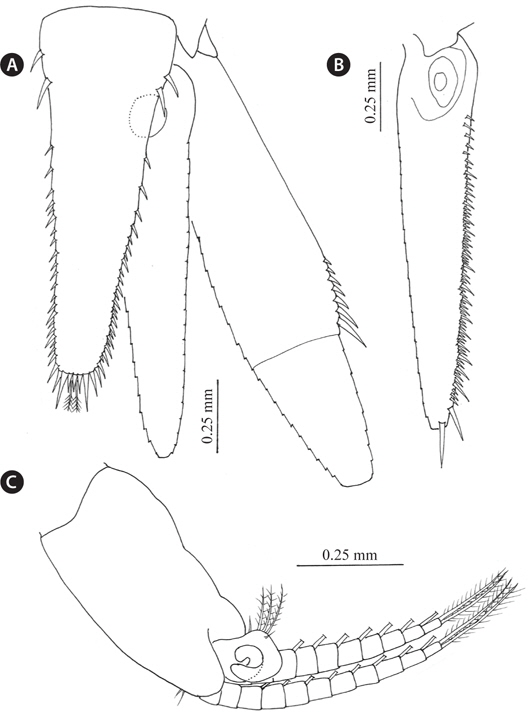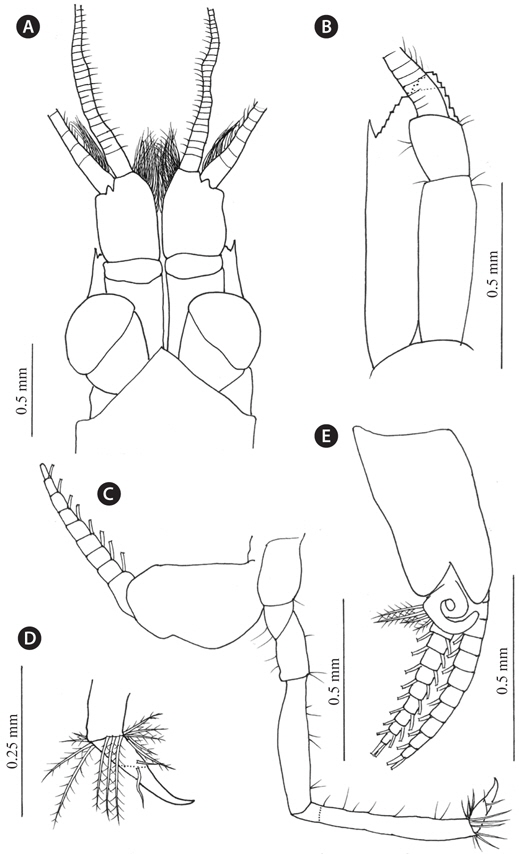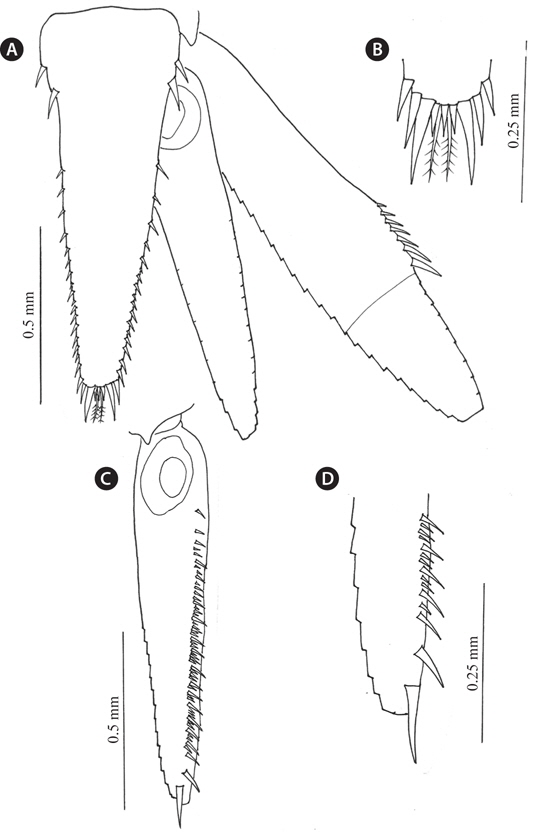



Two pelagic species Siriella izuensis Murano and Fukuoka, 2008 and Siriella japonica Ii, 1964, are reported for the first time from the Korean waters, together with descriptions and illustrations. S. izuensis can be distinguished from its closest relative, Siriella japonica, by the normal inner flagellum of the antennule of males, as opposed to the swollen proximal part in S. japonica, and by the slightly more distinct tendency of alternate arrangement of spines on the distal third lateral margin of the telson than in S. japonica. S. izuensis and S. japonica differ distinctly from other related species by a combination of the triangular rostral plate, the moderate size of the eyes, the form and arrangement of the lateral spines of the telson, and six or seven graded spines on the distal outer margin of the uropodal exopod. A taxonomical key is given for the genus Siriella from the Korea waters.
The genus
During a recent survey in the Korean waters,
All specimens were collected using a light trap at night. Collected mysids were immediately fixed in 10% buffered formalin solution on the shore and washed in distilled water before being preserved in the laboratory. Total length was measured from the tip of rostrum to the end of telson. Illustrations were made with the aid of a camera lucida under a microscope (Optiphot-2, Nikon, Japan). Images were also recorded with a digital camera (D5000, Nikon, Japan) under a dissecting microscope (SMZ-U, Nikon, Japan).
Order Mysida Haworth, 1825 Family Mysidae Haworth, 1825 Subfamily Siriellinae Norman, 1892 Genus Siriella Dana, 1850 (New Korean name: Na-seon-gon-jaeng-i-sok)
Type locality. Suruga Bay off Mera, Izu Peninsula, Japan.
Material examined. Seven adult males (6.5–7.5 mm), ten adult females (6.5–8.5 mm), 34° 54΄ 0.25˝ N, 128° 27΄ 21.62˝ E, Wonpyeong-ri, Yongnam-myeon, Tongyeong-Si, Gyeongsangnam-do, light trap, 29 September 2013, S.-G. Jo.
Description. Body robust (Fig. 1). Anterior margin of carapace (Fig. 2A) produced into triangular rostral plate with slightly concave lateral margins. Anterior margin of cephalon rounded. Eyes (Fig. 2A) longer than broad, reaching distal margin of first segment of antennular peduncle; cornea occupying almost half of whole eye. Antennal scale (Fig. 2A and 2B) reaching 2/3 of third segment of antennular peduncle, almost three times as long as broad; outer margin naked and terminating in a prominent spine extending beyond antennal peduncle; suture distinct. Antennular peduncle of male (Fig. 2A) stout; third segment almost same length as first; inner flagellum slender and not swollen at proximal part; appendix masculina with densely armed with sensory hairs. Endopod of third to eighth thoracic limbs (Fig. 2C and 2D) with a bent terminal claw; carpopropodus armed with terminal brush of setae on distal margin; exopod with 12-segmented flagellum. Pleopods of male (Fig. 3C) biramous, with spirally coiled pseudobranchial rami in second to fourth pairs and with straight ones in first and fifth pairs; both endopod and exopod 11-segmented. All setae normal. Endopod of uropod (Fig. 3A and 3B) extending beyond telson, densely armed with series of short and long spines along inner margin, spines increasing in size distally. Exopod of uropod two-jointed, extending beyond endopod, and armed with several graded spines occupying about 1/4 of outer margin of proximal joint. Telson (Fig. 3A) about 2.7 times as long as broad at base; lateral margin armed with two larger spines proximally and alternating long and short spines distally; apex rounded, armed with a pair of setae and five spines, of which two outer ones much longer than three inner ones.
Remarks. Ii (1964) originally described this species as
Distribution. The South Sea in Korea (present study); the Yellow Sea, the Bohai Sea, and the South China Sea in China (Liu and Wang, 2000); coasts of the warm-water region of Honshu, Japan (Ii, 1964; Murano and Fukuoka, 2008).
>
Siriella japonica Ii, 1964 (new Korean name: Bu-eun-pyeon-mo-na-seon-gon-jaeng-i) (
Not
Type locality. Port Oniwaki, Rishiri Island, Hokkaido, Japan.
Material examined. Two adult males (7.0 mm), three ovigerous females (6.0 mm), one adult female (6.0 mm), five immature males (4.0–5.1 mm), eight immature females (4.3–5.2 mm), four juveniles (4.0 mm), 34° 52΄ 25.12˝ N, 128° 28΄ 4.62˝ E, Jangpyeong-ri, Yongnam-myeon, Tongyeong-Si, Gyeongsangnam-do, light trap, 29 September 2013, S.-G. Jo; five immature females (5.0–5.2 mm), 37° 57΄ 15.89˝ N, 124° 44΄ 16.19˝ E, Jinchon-ri, Baengnyeong-myeon, Ongjin-gun, Incheon, light trap, 23 October 2012, B. H. Kim.
Description. Body robust (Fig. 4). Anterior margin of carapace (Fig. 5A) produced into a broad triangular rostral plate with nearly straight lateral margins. Anterior margin of cephalon rounded but almost invisible because the rostral plate covers it. Eyes (Fig. 5A) slightly longer than broad, falling short of distal margin of first segment of antennular peduncle; cornea broad, occupying more than half of whole eye. Antennal scale (Fig. 5A and 5B) reaching two thirds of third segment of antennular peduncle, almost three times as long as broad; outer margin naked and terminating in a prominent spine almost reaching distal end of antennal peduncle; suture distinct. Antennular peduncle of male (Fig. 5A) stout; third segment almost same length of first; inner flagellum slender and slightly swollen at proximal part; appendix masculina with densely armed with sensory hairs. Endopod of third to eighth thoracic limbs (Fig. 5C and 5D) with a bent terminal claw; carpopropodus armed with terminal brush of setae on distal margin; exopod with nine-segmented flagellum. Pleopods of male (Fig. 5E) biramous, with spirally coiled pseudobranchial rami in second to fourth pairs and with straight ones in first and fifth pairs; both endopod and exopod 11-segmented. None of the setae modified. Endopod of uropod (Fig. 6A and 6C) slightly extending beyond telson, densely armed with series of short and long spines along inner margin, spines increasing in size distally. Exopod of uropod two-jointed, extending beyond endopod, and armed with several graded spines occupying about one third of outer margin of proximal joint. Telson (Fig. 6A) about 2.8 times as long as broad at base; lateral margin armed with two larger spines proximally to others and alternating long and short spines distally; apex rounded, armed with a pair of setae and five spines, of which two outer ones much longer than three inner ones.
Remarks.
Distribution. The South Sea and Yellow Sea in Korea (present study); the Yellow Sea, the Bohai Sea, and the South China Sea in China (Liu and Wang, 2000); coasts of Honshu, Japan (Ii, 1964; Murano and Fukuoka, 2008).
>
Key to the species of the genus Siriella from the Korean waters
1. Uropodal endopod longer than exopod...............................2
- Uropodal endopod shorter than exopod................................3
2. Rostral plate shortly pointed; cornea of eye occupying less than half of whole eye............................
- Rostral plate sharply elongated; cornea of eye greatly expanded, occupying almost half of whole eye.................................................................
3. Inner flagellum of male antennule swollen in proximal part ................................................................................................4
- Inner flagellum of male antennule normal in proximal part................................................................................................6
4. Inner flagellum of male antennule moderately swollen in proximal part; prominent spine on outer distal margin of antennal scale almost reaching distal end of antennal peduncle ...................................................................
- Inner flagellum of male antennule remarkably swollen in proximal part...........................................................................5
5. Prominent spine on outer distal margin of antennal scale falling short of distal end of antennal peduncle...........................................................................
- Prominent spine on outer distal margin of antennal scale extending far beyond distal end of antennal peduncle.......................................................
6. Triangular rostral plate elongated, covering anterior margin of cephalon....................................................
- Triangular rostral plate shortly pointed, not covering anterior margin of cephalon......





